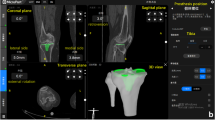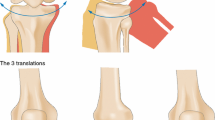Abstract
As uptake of robotic-assisted arthroplasty increases there is a need for economic evaluation of the implementation and ongoing costs associated with robotic surgery. The aims of this study were to describe the in-hospital cost of robotic-assisted total knee arthroplasty (RA-TKA) and robotic-assisted unicompartmental knee arthroplasty (RA-UKA) and determine the influence of patient characteristics and surgical outcomes on cost. This prospective cohort study included adult patients (≥ 18 years) undergoing primary unilateral RA-TKA and RA-UKA, at a tertiary hospital in Sydney between April 2017 and June 2021. Patient characteristics, surgical outcomes, and in-hospital cost variables were extracted from hospital medical records. Differences between outcomes for RA-TKA and RA-UKA were compared using independent sample t-tests. Logistic regression was performed to determine drivers of cost. Of the 308 robotic-assisted procedures, 247 were RA-TKA and 61 were RA-UKA. Surgical time, time in the operating room, and length of stay were significantly shorter in RA-UKA (p < 0.001); whereas RA-TKA patients were older (p = 0.002) and more likely to be discharged to in-patient rehabilitation (p = 0.009). Total in-hospital cost was significantly higher for RA-TKA cases (AU$18580.02 vs $13275.38; p < 0.001). Robotic system and maintenance cost per case was AU$3867.00 for TKA and AU$5008.77 for UKA. Patients born overseas and lower volume robotic surgeons were significantly associated with higher total cost of RA-UKA. Increasing age and male gender were significantly associated with higher total cost of RA-TKA. Total cost was significantly higher for RA-TKA than RA-UKA. Robotic system costs for RA-UKA are inflated by the software cost relative to the volume of cases compared with RA-TKA. Cost is an important consideration when evaluating long term benefits of robotic-assisted knee arthroplasty in future studies to provide evidence for the economic sustainability of this practice.
Similar content being viewed by others
Data availability
Data supporting this study are not publicly available due to privacy constraints on highly sensitive medical data. The data that support the findings of this study may be made available on reasonable request from the corresponding author by contacting our institution at SLHD-SOuRCe@health.nsw.gov.au.
References
Carr AJ et al (2012) Knee replacement. Lancet 379(9823):1331–1340
Price AJ et al (2018) Knee replacement. Lancet 392(10158):1672–1682
Long H et al (2022) Prevalence trends of site-specific osteoarthritis from 1990 to 2019: findings from the global burden of disease study 2019. Arthritis Rheumatol 74(7):1172–1183
Australian Orthopaedic Association National Joint Replacement Registry (AOANJRR), (2022) Hip, Knee, Shoulder Arthroplasty: 2022 Annual Report. Adelaide. 1–148.
Lan YT et al (2023) The trend and future projection of technology-assisted total knee arthroplasty in the United States. Int J Med Robot 19(1):e2478
Heinz T et al (2023) Trends in computer-assisted surgery for total knee arthroplasty in Germany: an analysis based on the operative procedure classification system between 2010 to 2021. J Clin Med. https://doi.org/10.3390/jcm12020549
Vaidya NV et al (2022) Robotic-assisted TKA leads to a better prosthesis alignment and a better joint line restoration as compared to conventional TKA: a prospective randomized controlled trial. Knee Surg Sports Traumatol Arthrosc 30(2):621–626
Clark TC, Schmidt FH (2013) Robot-assisted navigation versus computer-assisted navigation in primary total knee arthroplasty: efficiency and accuracy. ISRN Orthop 2013:794827
Chin BZ et al (2021) Robot-assisted versus conventional total and unicompartmental knee arthroplasty: a meta-analysis of radiological and functional outcomes. J Knee Surg 34(10):1064–1075
Karunaratne S et al (2019) The effectiveness of robotic hip and knee arthroplasty on patient-reported outcomes: a systematic review and meta-analysis. Int Orthop 43(6):1283–1295
Kayani B et al (2018) Robotic-arm assisted total knee arthroplasty is associated with improved early functional recovery and reduced time to hospital discharge compared with conventional jig-based total knee arthroplasty: a prospective cohort study. Bone Joint J 100:930–937
Shearman AD et al (2021) Robotic-assisted unicompartmental knee arthroplasty is associated with earlier discharge from physiotherapy and reduced length-of-stay compared to conventional navigated techniques. Arch Orthop Trauma Surg 141(12):2147–2153
Kolessar DJ et al (2022) Robotic-arm assisted technology’s impact on knee arthroplasty and associated healthcare costs. J Health Econ Outcomes Res 9(2):57–66
Steffens D et al (2022) Implementation of robotic-assisted total knee arthroplasty in the public health system: a comparative cost analysis. Int Orthop 46(3):481–488
McBride K et al (2021) Detailed cost of robotic-assisted surgery in the Australian public health sector: from implementation to a multi-specialty caseload. BMC Health Serv Res 21(1):108
von Elm E et al (2014) The Strengthening the Reporting of Observational Studies in Epidemiology (STROBE) statement: guidelines for reporting observational studies. Int J Surg 12(12):1495–1499
Jackson T (2000) Cost estimates for hospital inpatient care in Australia: evaluation of alternative sources. Aust N Z J Public Health 24(3):234–241
Moschetti WE et al (2016) Can robot-assisted unicompartmental knee arthroplasty be cost-effective? A Markov Decision Analysis J Arthroplasty 31(4):759–765
Kendrick AM et al (2023) Retrospective analysis of robotic unicompartmental and total knee arthroplasties: patient demographics and outcomes. J Osteopath Med 124(21):25
Acknowledgements
We would like to thank the Sydney Local Health District Performance Unit for their support provided towards this manuscript.
Funding
The authors declare that no funds, grants, or other support were received during the preparation of this manuscript.
Author information
Authors and Affiliations
Contributions
All authors contributed to the study conception and design. Material preparation, data collection and analysis were performed by Kate Alexander, Sascha Karunaratne and Daniel Steffens. The first draft of the manuscript was written by Kate Alexander and all authors commented on previous versions of the manuscript. All authors read and approved the final manuscript.
Corresponding author
Ethics declarations
Conflict of interest
The authors have no relevant financial or non-financial interests to disclose.
Ethics approval
Ethics approval was granted by the Sydney Local Health District Human Ethics Committee (X19-0456, HREC number: 2019/ETH13554). A waiver of consent was approved for the analysis of routinely collected data for use in this study.
Additional information
Publisher's Note
Springer Nature remains neutral with regard to jurisdictional claims in published maps and institutional affiliations.
Supplementary Information
Below is the link to the electronic supplementary material.
Rights and permissions
About this article
Cite this article
Alexander, K., Karunaratne, S., Sidhu, V. et al. Evaluating the cost of robotic-assisted total and unicompartmental knee arthroplasty. J Robotic Surg 18, 206 (2024). https://doi.org/10.1007/s11701-024-01932-8
Received:
Accepted:
Published:
DOI: https://doi.org/10.1007/s11701-024-01932-8




